The Three Minute Thesis (3MT) celebrates the exciting research conducted by Doctor of Philosophy (PhD) and Professional Doctorate (Research) candidates. It is an international academic competition developed by the University of Queensland to cultivate students’ academic, presentation, and research communication skills.
3 Minute Thesis 2022
2022 UTS 3MT Winners
This year's 3MT finals returned to an in-person event with an online session available to audiences via Zoom. The diversity of graduate research at UTS was showcased across eight Faculties. It was a difficult but unanimous decision from the judges in choosing the winner and runner-up award for 2022 UTS 3MT, while our in-person and online audience were busy voting for their People's Choice.
And, the 2022 prizes were awarded to:
- Megan Taylor (Faculty Design, Architecture and Building) for her topic "Sydney, It's Not Easy Being Green"
First prize: $3000 and representing UTS at 2022 Asia-Pacific 3MT competition - Ayusha Dahal (Faculty of Science) for her topic "The Search For The Unidentified"
Runner-up: $1000 and People's Choice: $1,000
Megan took out the $3,000 winner’s prize for her three minutes on the urban planning challenges being faced by Sydney’s green spaces and will represent UTS at the 2022 Virtual Asia-Pacific 3MT Semi-finals on 26 September.
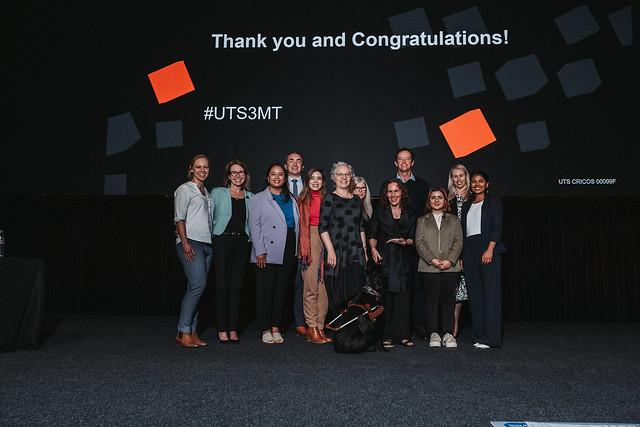
From Left to Right: Isabelle Schaefer (Health), Rowena Ditzell (Business), Indra Mckie (FASS), Chris Turney (Judge), Caroline Valente (Judge), Dilek Cetindamar Kozanoglu (Judge), Professor Hélène de Burgh-Woodman (MC), Megan Taylor with Lady (Winner, DAB), Jason Graham-Nye (ISF), Ayusha Dahal (Runner-up and People's choice, Science), Karen Donner (Law), Kavindie Hansika Katuwandeniya (FEIT).
2022 Faculty Finalists
Overall winner: Megan Taylor, Faculty of Design, Architecture and Building
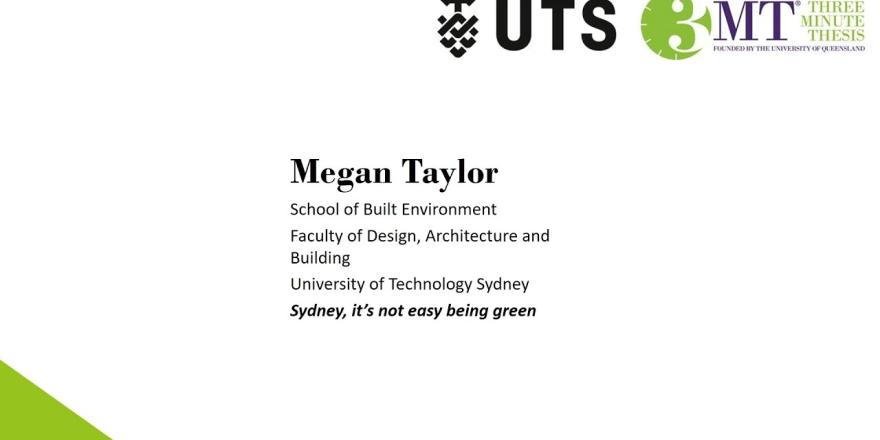
Transcript: Megan Taylor, "Sydney: it's not easy being green"
Who else fell in love with their local park through lockdown, sidestepping those picnic rugs wasn’t easy, and I'm not saying I didn't invite my husband, but sometimes I took advantage of those restrictions and he didn't make the cut. History shows us this won't be the last time we use our local parks as a panacea for urban de-stressing or to improve public health.
The difference this time it affected all of us. So it's important we understand what's happening with our local parks, because if the mechanisms used to put them in place are not meeting scalable expectation, we're going to end up with a city that does not function. And trust me, there are all sorts of reasons you don't want to live in a city without enough parks.
Spoiler alert. That's where we're heading. I know this through using COVID as a natural experiment, I wanted to see if planning for local parks had changed as a result of the new normal. Adopting a Delphi method, I surveyed and interviewed a group of highly experienced urban planners from across state and local government organisations in Sydney to see if a consensus was emerging about the post-COVID importance of local park provision and if so, what actions were underway.
My results were discouraging. One, land is outrageously expensive and scarce in developed areas. Two, developer contributions are not adequate subsidy for the new park spaces required to serve new residents. Three local parks are low on the amenity grocery list because they are not a direct driver of economic growth. They don't fund revenue the way that, say, car parks do.
The solutions, Firstly, we get a lot more inventive and flexible with existing public open space parklets smart parks, rooftop parks. They're all in our future. Secondly, we recognise society can't function without the extraordinary health and social benefits provided by our local parks. They need to be funded and prioritised accordingly. Lastly, we need to rethink our government priorities. Do we build car parks because they are funded by revenue and not local parks because they consume revenue.
My thesis provides a platform for a broader conversation about how we value and treat our local parks. Policy is like a promise. It's where things happen and decisions built. And if we change that and we change this conversation because it's not set in stone, we can change our future and maybe change the world. And what's a world without parks, picnics and friends?
Thank you.
Runner-up and People's Choice Winner: Ayusha Dahal, Faculty of Science
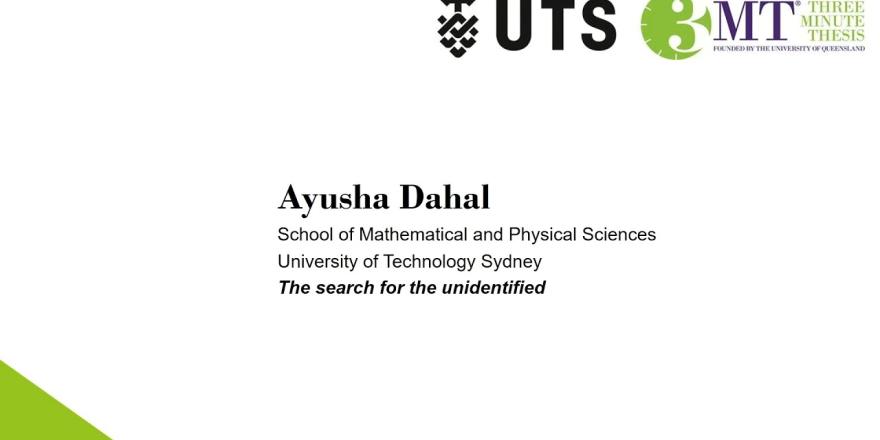
Transcript: Ayusha Dahal, "The search for the unidentified"
Let's begin by having a look at the skull. Who is he? Where is he from? What is his age? Is he even a he? Unfortunately, I do not have any answers for you yet. And that is the fate of over 500 unidentified human remains in Australia with no information available to identify them. Alongside, Australia has more than 2500 long term missing people. This means that there are thousands of Australian families living in perpetual trauma over the fate of their missing relative. Now several countries have successfully established programs to identify their human remains. However, efforts towards this issue was lacking in Australia until very recently. And this is where forensic researchers like myself come in. As part of my research, I'm looking into assessing the accuracy of the available human identification techniques for their use in Australian investigative cases.
The techniques that I'm focusing on are forensic anthropology, forensic ontology, radiocarbon dating, isotope analysis and DNA testing. I know there was a lot, so to break it down, these are techniques that are able to provide us with information such as this skulls, age, sex and ancestry. And these are important categories. They form the main profile of a skull or a human remain that can then be compared to the existing information on a missing persons database.
Now, by now you've probably guessed about my sample type. Yes, I am focusing on a skull because it is more commonly recovered as it is quite resistant to the various environmental factors. For my project I've been allocated eight human cadavers donated as part of the UTS body donation program. Now I've had to excavate most of these donors myself de-flesh them and wait for what seems like forever for them to naturally skeletonise.
So we've actually been through a lot together. Only recently I was able to take measurements of distinct landmarks within the skull, and this was to identify any patterns that might exist in the skull’s size and shape that is reflective of its geographic origin, meaning ancestry. And the size and shape information also provides sex information. Next is DNA analysis and the other techniques, which will provide its own estimates of age, sex and ancestry.
So there are direct implications of the findings of my research for human remains identification in Australia. Hopefully this means that it is not too long before we can provide some much-needed answers to those families waiting for any news about their missing relative. It also means that I will finally be able to tell you who unknown X really is.
Thank you.
Indra Mckie, Faculty of Arts and Social Sciences
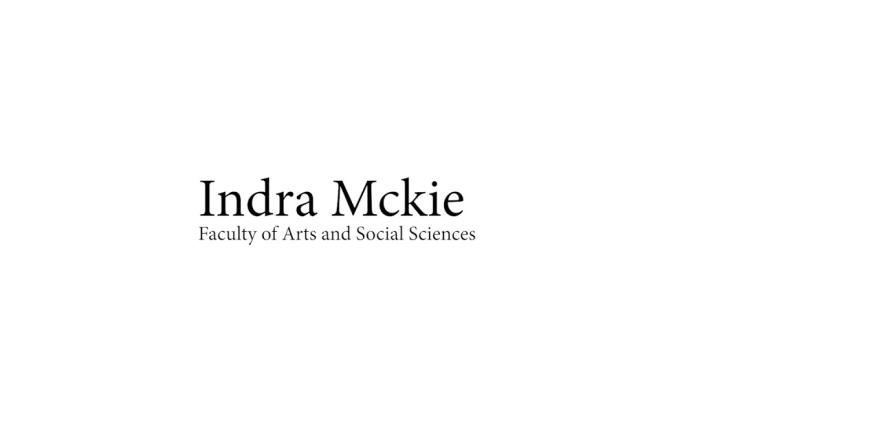
Transcript: Indra Mckie, Faculty of Arts and Social Sciences
Okay, Google, tell me how many people in Australia use voice assistants. Google isn't plugged in right now, but what a strange experience asking a question to a talking A.I.? Usually I would just google something on my phone. I'm already on it 8 hours a day. But researchers have told us that using technology like our phones can be isolating and distracting.
Every day we see more people attached to a screen. But what happens when we take away the screen and expand the space of interaction from this to this? When we use voice assistants, we can interact from anywhere where anyone could join in on the conversation. Right now, research is focused on the technical. How do we create smarter, faster AI?
But even when the technology is so advanced, why is it that only 26% of Australians use voice assistants? Why not more? I took a human centered perspective to understand how people are really using this technology beyond just playing musical, asking for the weather. So I interviewed ten families to understand how living with a talking A.I. had changed their lives.
And wow, I found some fascinating things stories where we never thought that voice assistants would ever be a part of, like Lien and Siri, who keep the kids entertained together during homework, or Amal and her boyfriend who have three way discussions with Google just trying to settle an argument, or Mark who started asking Alexa to do things that Mom used to do. She wasn't too pleased about her replacement or Stella, who just appreciated hearing another voice, tell her good night when she was stuck alone during COVID lockdowns. The families had formed new behaviors and their relationships with each other had evolved to adapt to the new family member. From my research developers can create new skills or features informed by the creative resourceful ways that real people have reimagined what voice assistants can do. I document these stories because without them we'll continue to create technology that ignores the human experience because it's up to us to teach and build artificial intelligence to work with us and not against the things we hold dear, but instead creating experiences that we can share together. Okay Google, you might be helpful now but it's up to us for what you can do next.
Thank you.
Isabelle Schaefer, Faculty of Health
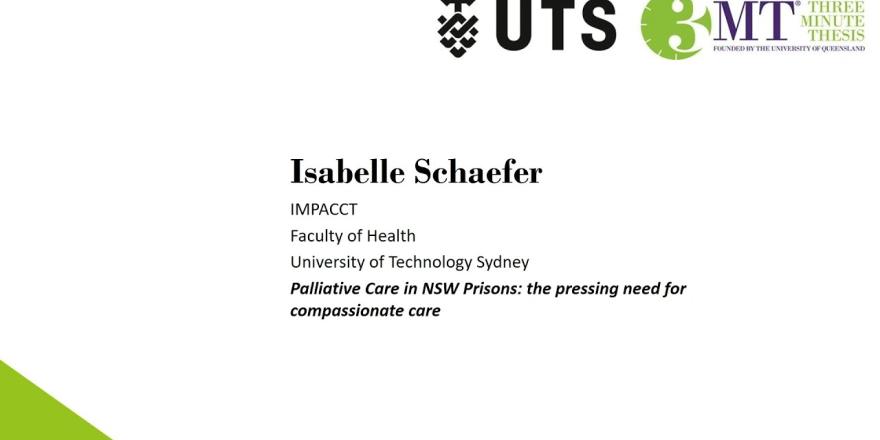
Transcript: Isabelle Schaefer, "Palliative Care in NSW Prisons: the pressing need for compassionate care"
Imagine you're lying in bed. The pain in your chest is bad tonight.
It burns with each breath you take.
But your breasts are desperate and rapid because you can't seem to get enough oxygen. The doctors say the cancer is spreading. You can't even go to the toilet on your own anymore. You need another inmate to help you. You could press the call button, but it will take half an hour for the medical staff to get to you behind the locked doors. And anyway, all they can do is give you paracetamol.
You're dying alone in your cell, away from your family. You try to turn over to get more comfortable, but your hand jerks to a halt. You forgot you were handcuffed to the bed. Dying in prison is a hidden problem, but a growing one. The number of older people in prison is growing faster than any other age group, and they're in much poorer health then people in the community.
But the prison environment is not designed to care for people at the end of life. At its core, a prison is designed to be a place of punishment. How we can best manage people in prison with palliative care needs is a question I am investigating as part of my PhD research focusing in New South Wales and the more than 3000 older people in prison here to improve palliative care, we need to understand how people are cared for now and the major issues they face accessing basic end of life care, things like a shortage of nurses, which means dying patients need to be fed and dressed by other inmates, like not being able to access a shower and clean clothes if patients lose control of their bowels overnight, like not being able to go outside because a patient needs continuous oxygen, but the prison doesn't have any portable tanks. Those are all real examples, Real issues faced by people in prison who are dying. Through my research, I'm asking people involved in providing palliative care to people in prison to talk to me about their experiences. What they see are the biggest issues that prevent them from providing the basic end of life care that is every person's right. By getting their insight, we will better understand how the prison environment affects palliative care delivery and how stakeholders can work together to overcome these barriers. My research will contribute to a world first national project, working with every correctional health care and custodial organisation in Australia, with researchers, educators and palliative care experts to map out a strategy.
The National Framework for provision of palliative care in Australian prisons to ensure that people in prison can die with dignity because at the end of the day, everybody deserves that. Right.
Thank you.
Jason Graham-Nye, Institute for Sustainable Futures
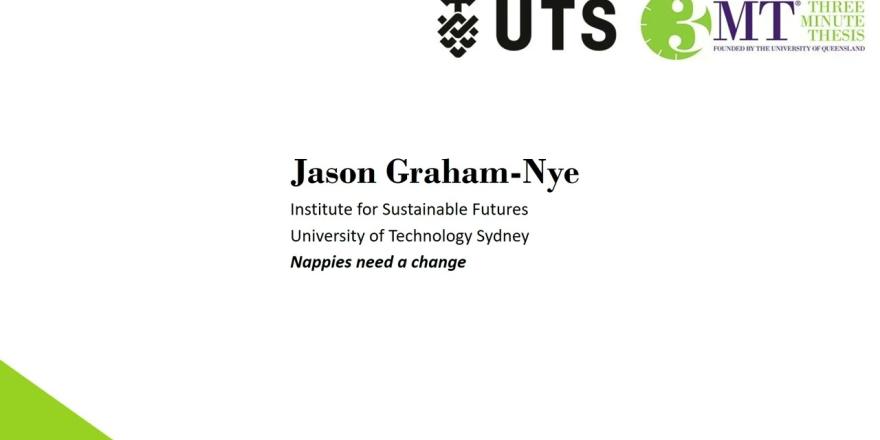
Transcript: Jason Graham-Nye, "Nappies need a change"
This is a baby. We've all been one. This one's just three days old. But despite the cute good looks and that tiny amount of time, he's become somewhat of an environmental terrorist. How? Well, in his first 72 hours on life, he's worked his way through 30 plastic disposable nappies. How bad can nappies be? Well, there's a cup of crude oil in everyone.
And after a few hours of use, you put them in the bin, send them to landfill where they stay for up to 500 years before breaking down into microplastics. This baby will go through 5000 nappies before he figures out how to use a toilet. Globally, that's 167 billion nappies, using 16,000 Olympic swimming pools worth of crude oil. Now, this baby happens to be my son, Finn, and this photo was taken 20 years ago this week. And when my wife and I read those statistics, we thought, what if we could offer parents a product that didn't have to cross the earth? And it set us off on a lifelong journey for solutions. Firstly, as entrepreneurs in a business and now in academic research, we started by looking for practical solutions and found a new nappy design with an outer pant that was washable and an insert that was compostable.
We used it as parents, put the rights to the rest of the world, moved to America and launched a nappy business. We had great success, but we noticed there was something missing and that the nappy wasn't being widely used. Now, our consumer research showed that while most people say they'll make the Green Choice, a very small percentage actually do.
So even with a better for the planet nappy. What we were finding was the barriers to using environmentally friendly nappies was unclear. So with few answers in the business world, I turned my attention to academia and there I found new perspectives on how green product choices are made. My research is focused on how parents buy, use and dispose of nappies.
Now, rather than starting with attitudes and beliefs about nappies, I'm looking at every element along the way of the nappy journey from the manufacturers who make them to the retailers, who sell them to the parents, who buy and dispose of them, to the waste management companies and the waste regulators who manage the waste management companies. I'm hoping to see how a new innovation can take hold.
And I'm also looking at a field trial of a new compostable nappy that produces high quality compost rather than millions of tonnes of plastic waste. The opportunity there is to see is that solution feasible for parents and appealing? Because if it is, we might live in a world where, rather than using 16,000 Olympic swimming pools worth of crude oil to make the world's nappies, we're creating regenerative nappies that's produced 16,000 tonnes of high quality compost to replenish the Earth. And for my son Finn here, if he chooses to be a parent choosing a nappy that's as good for the planet as it is for his little one will be as normal as buying plastic nappies today.
Thanks.
Karen Donner, Faculty of Law
Karen's video is not available; please see the transcript:
This is a photo of Min and Rose. They recently suffered a mishap at Zumba and they both broke their shoulders. Min’s 80 and she lives in the home where she raised her family. Rose has lived in her unit for the last 50 of her 90 years. Both are in great health. Rose thinks that's because she's never had to worry about a partner or kids. Before they can be discharged from hospital, the social worker says they'll need to arrange support at home. Rose calls My Aged Care answers a heap of questions and tries not to sound too decrepit. A RAS assessor calls her, asks more questions and tells her she can get some entry-level services like cleaning and shopping. Min’s daughter calls My Aged Care for her. She's had experience with aged care assessments for her father and insists Min has an ACAT assessment, not a RAS. Min is assessed as eligible for a level two home care package, which will help with her personal care. Min goes home with her daughter to care for her until she gets her package. Rose also goes home, but briefly, because she falls and breaks her other arm trying to dress herself. This time, the social worker calls my Aged Care and an ACAT assessor visits Rose. The ACAT says she's eligible for a level three home care package, but she can't make her high priority, so she'll need to go to an aged care facility for now. The assessor’s office has already hit a 15% cap on high-priority cases for this month.
With the length of the queue for home care packages, Rose will probably wait for about six months. The assessor is busy, so she also approves her for permanent residential care, so she doesn't have to go back and assess her again too soon. Rose moves to the nicest facility her niece from Perth can find. Rose hates residential care. She loses her zest for life, her health declines and her stay is extended. Ten months later, Rose is found dead in her room. She's still waiting for that home care package.
Rose is based on my neighbour whose experience led me to pursue this research. The Australian Government rations aged care resources by capping funding to the sector. The Royal Commission recommended needs-based funding to replace this rationing. The rationing also occurs at an individual level through the assessment process. The significance of my research is in understanding this micro-level rationing.
I'm using a mixed methods research strategy to understand how rationing occurs in the assessment process, how it's regulated, and how it impacts older Australians. The Research includes four phases: documentary research, using the data gathered by the Royal Commission; legal research to understand the legal framework for assessments; interviews with ex-ACAT assessors across Australia; and interviews with a case study of current assessors.
Rose’s story illustrates my findings to date. The current assessment process causes many older Australians to move prematurely into residential care or die waiting for appropriate home care. The Australian Government is developing new aged care laws and a new home care program. The key impact of my research is using my findings: to evaluate these reforms; and to identify changes that will enable a fairer allocation of resources, so we can stop neglecting older Australians and treat them with care, dignity and respect.
Kavindie Hansika Katuwandeniya, Faculty of Engineering and Information Technology
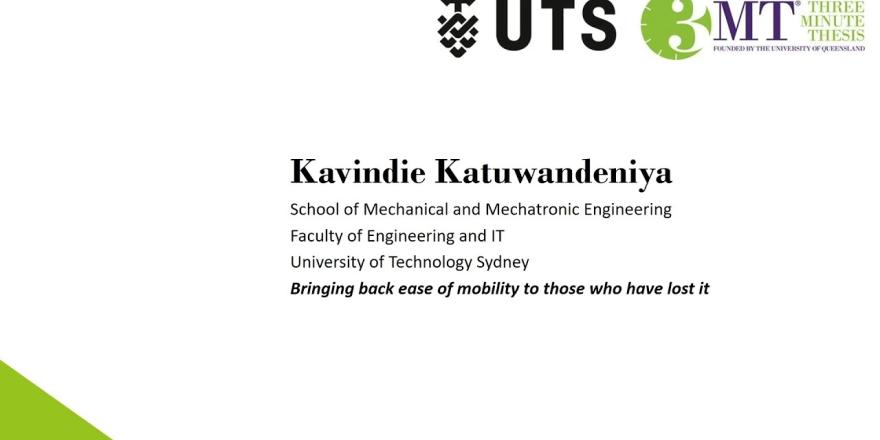
Transcript: Kavindie Hansika Katuwandeniya, "Bringing back ease of mobility to those who have lost it"
Walking comes natural to most of us as humans, we excel at subconsciously planning our immediate next steps by just a glance of our surroundings. However, driving a car, for example, requires far more concentration. Thus, the heavy cognitive burden falls on a driver. Unfortunately, not all of us can get around as easily as walking. If you cannot walk or have difficulty walking, you might drive something like this: A motorised wheelchair.
Users of such mobility aids have to concentrate all the time, arguably more so than drivers on the road due to the unstructured nature of the environment and lack of road rules. My research is about developing intelligent mobility AIDS that can help reduce this cognitive burden on the users while preserving their autonomy. I want to emphasise this autonomy or feeling of control, which is very important for someone who has lost a certain degree of control in their lives. In order to achieve this, I'll look into two aspects estimating the intention of the user and sharing control with the user.
To act on and assess the user, we first need to understand intention. Even defining using tension itself is challenging an undetermined state, meaning there is no one right answer. In my work, I estimated the using tension as the immediate future trajectory the user wishes to follow. This is predicted using the immediate past trajectory and external environmental information captured by an everyday colour camera.
Now for the second part, sharing the control with the user while preserving the autonomy. What better way to interact with the user than to use the controls they are already familiar with, like the joystick of the wheelchair. This way the user can relax and let the machine drive as its predicted path. However, if the user is not happy with where or how they're being driven, they can simply resume control and drive as they wish based on the user's input, the system rapidly updates its prediction and is back on track in no time with this setup, I have found that the users can relax, let go of the control about three quarters of the time.
75 million people around the world require a wheelchair on a daily basis. With the aging population, intelligent Mobility Aids such as the one I describe to you today, have the potential to benefit a large number of people than ever before.
With my research, I aim to bring back ease of mobility to those who have lost it. Thank you.
Rowena Ditzell, Faculty of Business
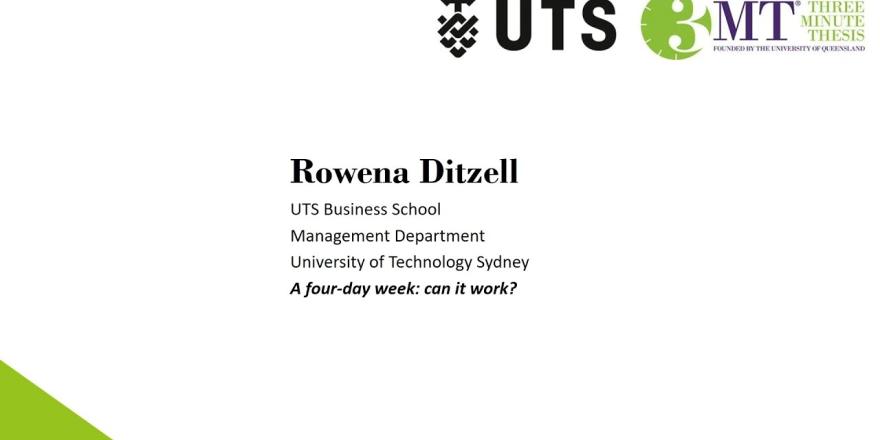
Transcript: Rowena Ditzell, "A four-day week: can it work?"
Meet Joel and Samir, both were working five days a week, but like 77% of all employees, they wanted more flexibility. For Joel, that meant more time with his kids. For Samir, it was time to study. Research proves the link between flexible work, work life balance and positive business outcomes, and the four-day week is an example of flexible work.
But when I talk about it, I find this one of two reactions, either bring it on right or a shake of the head. It won't work. You see we are all so busy. But despite this, some studies say in an average workday, only 3 hours is actually productive. The rest is spent on non-essential meetings, non-value add work and digital distractions.
So how would a four-day week even work and why would business do it? What if we could reimagine how we work to minimise wasted time, increase focus, maintain results, and give employees more flexibility? I ran an 18 month case study in a major multinational. I collected a huge amount of data in three phases. I ran three online surveys looking at metrics, including job stress and productivity.
I conducted over 60 interviews to understand lived experience. My findings showed the four day week is viable with positive business and employee outcomes. I did find some roles are better suited than others. Success is contingent on changing how we work and management support is critical. Despite this, the business showed that absenteeism fell nearly 30% and the stress from juggling work and family fell over 70%. So after moving to a four-day week, Joe now looks a bit happier and looks after his kids one day a week. Samir has completed her master's and both are meeting their business results. My research will have real world impact. It is at the forefront of a new sustainable way of working that could transform the future of work.
Thank you.
